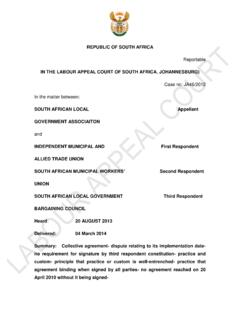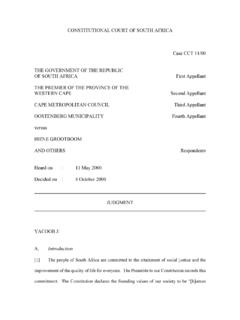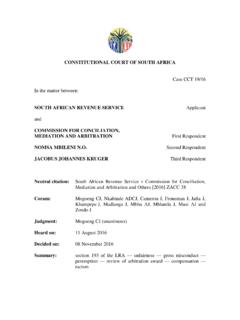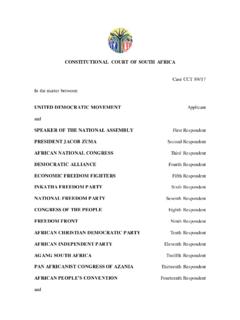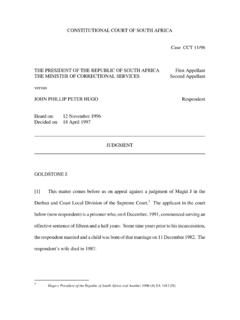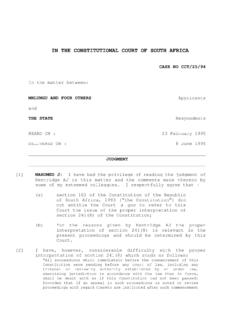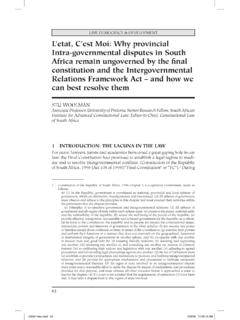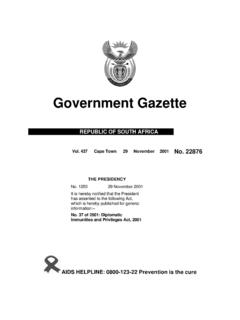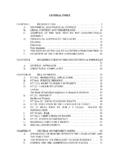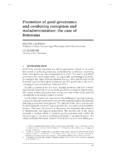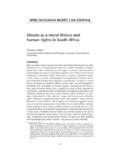Transcription of IN THE LAND CLAIMS COURT OF SOUTH AFRICA
1 1 Act 22 of 1994, as amended. IN THE land CLAIMS COURT OF SOUTH AFRICAHeld at RANDBURG on 7 - 10 Oct 2002, 1 Nov 2002, 9 Dec 2002 CASE NO: LCC 3/00before Moloto AJ and Wiechers (Assessor)Decided on: 23 December 2002 In the matter ofTHE NDEBELE-NDZUNDZA COMMUNITY concerningTHE FARM KAFFERSKRAAL NO 181 JS JUDGMENTMOLOTO AJ:[1] The Ndebele-Ndzundza Community claimed restitution of a right in land known as the farmKafferskraal No 181 JS in the district of Groblersdal, Mpumalanga Province, measuring 4210,8312 hectares in extent, in terms of the Restitution of land Rights Act1 ( the Act ). I shallrefer to it as the farm . The farm has undergone some name changes over time. It was firstknown as Kafferskraal No 1330, then Kafferskraal No 62 and finally, Kafferskraal No 181 it was part of the district of Middelburg. It has since been subdivided into severalportions and some portions were consolidated again.
2 It is now subdivided into three three portions have existed from at least 1902 to date. The claim included seventeen otherfarms, but the claim for these is still being processed in the Regional land ClaimsCommissioner s (RLCC) office. No explanation for the separation of the CLAIMS has beenproffered. [2] The claimant is a branch of the Ndebele called the Ndebele-Ndzundza tribe, residing ona farm called Goedgedacht (also known as Goedehoop ) in the Nebo district of the LimpopoProvince. The claimant elected a committee called Sibuyela Ekhaya land CLAIMS Committee toPage 2prosecute the land claim on behalf of the Community. The Committee in turn authorised itsChairman, Mr Zulu Simon Shabangu, to act on its behalf in prosecuting the claim and to sign alldocuments relating to the claim . A copy of the resolution of the claimant and the Committee, aswell as a list of the names of the members of the claimant form part of the documents in supportof the referral of the claim by the RLCC to the land CLAIMS COURT in terms of section 14(1) ofthe Act.
3 [3] The participating parties initially comprised the Department of land Affairs ( DLA ),against whom the claim lies, the respective owners of portions 1, 2 and 3, being DoringvalleiBoerdery, Mrs M C Prinsloo, the Botha Family Trust, and the respective bondholders overportions 1 and 2, being the land and Agricultural Bank of SOUTH AFRICA and ABSA Bank ofSouth AFRICA . The land and Agricultural Bank and ABSA Bank withdrew their oppositionagainst an undertaking by the DLA that in the event that the COURT orders restoration of the farmto the claimants, the indebtedness to the bondholders would be settled before payment of anycompensation to the owners of the various portions. At the beginning of the hearing of the casethe attorney for Doringvallei Boerdery advised that a settlement had been reached between herclient and the claimants. The terms of settlement have not yet been disclosed to the COURT ,presumably pending a decision on the opposition by the other two landowners.
4 The trialproceeded in respect of Portions 2 and 3 only. I shall refer to the owners of Portions 2 and 3collectively as the opposing parties . The DLA supported the claim .[4] The parties agreed to refer to trial, in terms of rule 57 of the Rules of COURT , the questionwhether the claim is valid, before dealing with the rest of the case. Put differently, the issue tobe determined is whether the claimant is entitled to restitution as contemplated in section 2 of theAct. The relevant portions of section 2 read- (1) A person shall be entitled to restitution of a right in land if- .. (d) it is a community or part of a community dispossessed of a right in land after 19 June1913 as a result of past racially discriminatory laws or practices; and (e) the claim for such restitution was lodged not later than 31 December 1998. (2) No person shall be entitled to restitution of a right in land if- Page 32 Section 1 of the Act.
5 3 Section 1 of the Act. (a) just and equitable compensation as contemplated in section 25(3) of the Constitution;or (b) any other consideration which is just and equitable,calculated at the time of any dispossession of such right, was received in respect of suchdispossession .A person includes a community or part [5] A right in land means any right in land whether registered or unregistered, and may include the interest of a labourtenant and sharecropper, a customary law interest, the interest of a beneficiary under a trustarrangement and beneficial occupation for a continuous period of not less than 10 years prior tothe dispossession in question .3 Finally racially discriminatory practices means racially discriminatory practices, acts or omissions, direct or indirect, by-(a) any department of state or administration in the national, provincial or local sphere ofgovernment;(b) any other functionary or institution which exercised a public power or performed a publicfunction in terms of any legislation.
6 [6] In order to determine whether the claimant is entitled to restitution as contemplated insection 2 of the Act certain questions need to be answered. These are: (a) whether there was a community as contemplated in the Act on the farm at anystage after 19 June 1913, and if so, what the identity of that community was. (b) If there was such a community, what rights in land such community held inrespect of the farm. Page 44 Rule 2 has been repealed by Government Notice R706 of 2001. 5 The Commission s Rules are contained in Government Notice 703 published in Government Gazette16407 of 12 May 1995, as amended. (c) If the community held a right or rights in land in respect of the farm, whetherthere was a dispossession of such right or rights as a result of past discriminatorylaws or practices. An answer to this question will entail the following:(i) When the dispossession occurred, if it did take place at all.
7 (ii) By whom the community was dispossessed of such right or rights.(iii) How the community was dispossessed of the right or rights. (iv) Whether the dispossession was as a result of past racially discriminatorylaws or practices. (d) Whether a claim was lodged for restitution of those rights in compliance withsection 2(1)(e) of the Act and whether there was substantial compliance with theprocedure prescribed for lodgement of CLAIMS in terms of section 10 read withsection 6(1)(a) and rule 24 of the Rules5 of the Commission on Restitution ofLand Rights ( the Commission ). The answer to these questions include thefollowing: (i) Whether the claim was lodged by the community or part of thecommunity.(ii) By whom and when the claim was lodged. (iii) Whether the person or persons who lodged the claim was or were dulyauthorised. (e) Whether the claim is not excluded in terms of the provisions of section 2(2).
8 To answer the above question the following must be answered. Page 56 Act 108 of 1996. (i) Whether the claimant received any compensation as contemplated in section25(3) of the Constitution6 or any other consideration. (ii) Whether such compensation or consideration if calculated as at the time ofdispossession would have been just and equitable. I proceed to examine the evidence in answer to the above questions:(a) Whether there was a community as contemplated in the Act on the farm at anystage after 19 June 1913, and if so, what its identity was.[7] Evidence on behalf of the claimant was to the effect that the history of the claimant startswith Ndzundza who is the first known leader of the tribe. A chart showing the succession of theKings and Chiefs of the claimant was handed into evidence by consent and marked Exhibit D .Exhibit D was said to have been prepared on behalf of the opposing parties.
9 It listed Ndzundzaas the first King of the tribe, with subsequent Kings and Chiefs names to the present day. MrMbulawa Abraham Mahlangu ( Mahlangu ) testified for the claimants. He stated that he wasborn on 12 September 1938. He is a member of the Ndebele-Ndzundza tribe. He has a soundknowledge of the history of the Ndebele-Ndzundza community, having developed an interest inthe community s history in 1962. His knowledge of the history of the community starts withNdzundza and extends to Ndzundza s descendants and other Chiefs. Mabhoko (mentioned inExhibit D ) was one such Chief. Although it was not expressly stated, it seems Mabhoko is theperson whose name was later misspelt as Mapoch and after whom the Mapoch War andMapochsgronde are named. Mahlangu testified that the Ndebele-Ndzundza community, underthese Kings and Chiefs, occupied the area from Mapochsgronde (where Mabhoko had built afortress for the community) and Roossenekal in the east to the Olifants River in the west,including the farm.
10 The history of the fortress, the war with Mzilikazi and the Mapoch War makeinteresting reading but are not absolutely relevant for purposes of this judgment. At the time ofsuch occupation, before whites came to the Transvaal, the area so occupied was not divided intofarms, it was just land of the Ndebele-Ndzundza community. The community established itselfon this land , reared livestock and cultivated the land . Page 67 Act 27 of 18 of terms of Act 27 of 1913 and Act 18 of 1936. [8] Mahlangu testified further that in 1883 a war broke out between the white government ofthe Republic of the Transvaal and the community and the war was called the Mapoch War. Thecommunity was defeated and the Government split the community. The Volksraad of theRepublic of the Transvaal decided to break up the nation of Mapoch . The community s landwas subdivided and allocated to whites who would be conferred with ownership of theirallotments after staying on them for 18 months.
